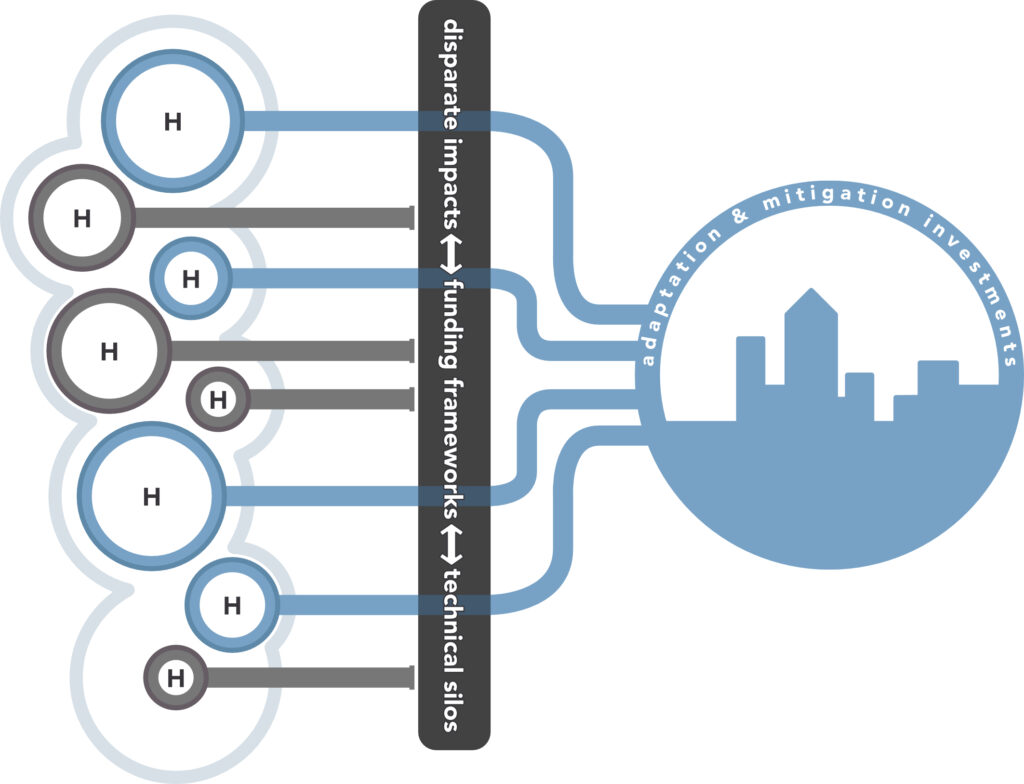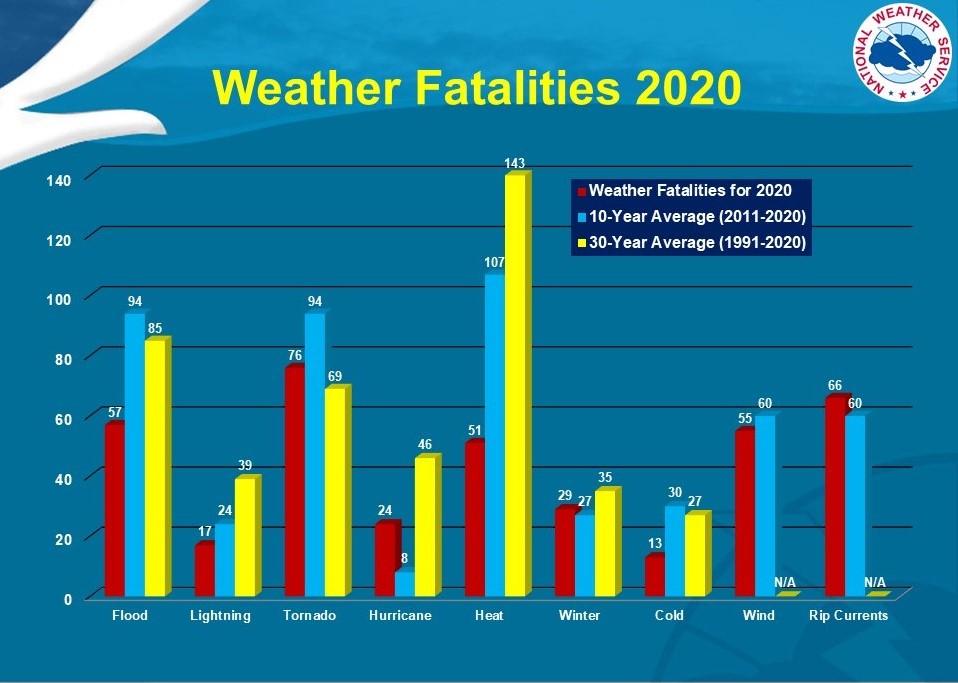
are we biased towards certain hazards?
Within our work in climate change mitigation and adaptation, we prioritize a nested-scales, all-hazards approach to identifying and addressing risks. Nested scales recognize the interconnectedness of systems, and of decisions that our clients may, or may not, control. All hazards reference climate hazards as well as other natural and human induced hazards that our clients might be exposed to, which in turn increase their vulnerability or require them to increase their adaptive capacity. Working in nested scales, and considering all hazards, improves the likelihood that any actions taken to reduce risks are appropriate to total exposures, comprehensive in terms of vulnerabilities and adaptive capacities, and inclusive of compounding impacts. However, one recurring issue we’ve observed involves the extent that key stakeholders and technical experts seem predisposed to single hazard over all-hazard, or even multi-hazard, approaches in adaptation and mitigation actions. Though climate scientists have been talking about compound (co-occurring) and cascading climate hazards for some time, we’re often surprised at how often many teams prioritize some hazards over others when addressing risks in their projects. We call this Hazard Bias.
We believe this “Hazard Bias” stems from the combination of (1) disparate impacts of lived experiences, (2) funding availability resulting from a federal disaster declaration process that prioritizes capital loss over loss of life, and (3) professional siloing in lieu of an inclusive approach leading to a narrowing of expertise in technical assistance in disaster responses.

While each individual factor can be a barrier to effective climate action, their naturally self-reinforcing feedbacks can result in potentially maladaptive investments that, at worst, increase overall risk and, at best, neglect opportunities to better leverage recovery and pre-disaster mitigation funding. Choosing to focus on a single hazard when a multi-hazard, and multi-benefit, solution could be developed is a type of maladaptation. This is an inherent organizational problem and an underrepresented challenge to effective action (Barnes & Dow, 2022).
maladaptive /ˌmaləˈdaptiv/ /ˌmæləˈdæptɪv/ [adj]: “not providing adequate or appropriate adjustment to the environment or situation.”
-OED
Lived Experience
We tend to internalize our day-to-day experiences as ‘normal’, and these experiences are often taken-for-granted. These “Lived Experiences” are the way things are. Lived experiences represent a tacit body of knowledge, echoing perceived realities, leading to normalized ways of doing things, which can be immensely helpful but can also present challenges. Lived experiences carry knowledge about coping strategies and ways of doing, passed between generations and amongst families and are extraordinarily valuable to understanding communities and their decision-making. These experiences can also reinforce habits of acceptance that are not always in the best interests of those same families. In hot regions, for example, living with heat and humidity is the norm. It’s ‘always been hot’ and the collective experience of living with that heat, and the routines developed to mitigate that heat, becomes a collective norm. But this collective experience is not equal. For the privileged, heat mitigation can include abundant air conditioning or traveling to a summer home in a cooler climate. For the privileged, heat is not exceptional as mitigating exposure and ready access to adaptive capacity is relatively easy. For those who are less privileged, heat mitigation is more challenging or impossible due to lack of air conditioning, or lack of resources to run air conditioning or to seek cooler shelter.
But the habit of acceptance can be demographically consistent: ‘it’s hot, and that’s just the way it is.’ The habit, or acceptance, of living with heat can reduce the likelihood of seeking alternatives, particularly in contexts where choices are limited, and heat is considered normal. This acceptance can override the ability to assign an appropriate level of danger to the condition, suppress our awareness of risk, and lead some to believe that they just aren’t vulnerable to the threat (Sheridan, 2007, pp. 10, 13). This is especially risky as the condition of ‘hot’ continues to change. As children of the South, this is not an academic assumption, but our lived experience. In these areas, though, other climate-related hazards can seem extraordinary for everyone. For Southern coastal communities like New Orleans or Charleston where the daily discomfort of extreme heat is normalized, flooding, by comparison, is always considered an event for which to prepare and recover. Flooding associated with catastrophic storms generates (understandably) significant pre- and post-storm attention and post-mortem analysis. The elevated water levels in streets and backyards and the resulting physical damage are not normal and viscerally shocking. Comparatively, no one wades through 3 feet of extreme heat and the lack of “visibility” of its impact is a central challenge to our ability to appreciate its significance. But this lack of appreciation can be deadly.
When Hurricane Katrina devastated Louisiana in 2005, the natural focus was on the extensive flooding and the tragic loss of life after the levee failures in New Orleans. It has been widely reported that of the 971 Katrina-related deaths in Louisiana, 40% of those were attributed to drowning. The other 60% were more vaguely categorized as trauma-related, and heart conditions (Brunkard, Namulanda, & Ratard, 2008). But there is strong evidence that the compound threats of wind, water, AND extreme heat was more deadly than acknowledged. When Hurricane Katrina knocked out power and water services to Memorial Medical Center, staff and critically ill patients were forced to shelter in place in a building that lacked basic design provisions and the necessary backup systems to operate safely in a catastrophic emergency. Temperatures inside the facility soared above 100 degrees and nurses and staff were faced with the horrific realization that not all patients could be evacuated or saved. The resulting chaos and disturbing decision to let some of the most critically-ill patients go is still agonizingly debated (Fink, 2009). Unsurprisingly, Memorial’s story is one told primarily about flooding, with lesser attention paid to the exposure to extreme heat for those with chronic conditions even though it was the heat that was the likely tipping point to that human disaster. With the benefit of hindsight, it is likely that a significant number of Katrina-related deaths were heat-related, but because this hazard was normalized and not a significant focus of post-storm forensics, those deaths were likely attributed to other causes.
In Louisiana, the legacy of Katrina led to the creation of flooding-focused programs that incubated many beneficial water-management projects in the State and to the establishment and growth of the water management industry, or “water economy,” (Greater New Orleans Foundation, 2022) in the State. However innovative, these projects largely ignore other hazards like heat. Heat is, after all, an expected norm and this familiar hazard has not, until recently, been considered a significant threat, and certainly has not been a requirement for consideration in most federal recovery funding, or in the various post-Katrina stormwater projects developed throughout the city. And while beneficial programs like Room for the River and its next iteration, Living with WaterTM attempt to reconcile water management more holistically, these paradigms largely bias to a single hazard: flooding. How did we get here?
Federal Disaster Declarations
In 1948, a catastrophic flood in the Midwest prompted the Congress of the United States to appropriate $500,000 for disaster relief and created what would become the Disaster Relief Fund (DRF). This appropriation is the modern funding mechanism for the Robert T. Stafford Disaster Relief and Emergency Assistance Act, passed in 1988, that, today, structures much of the Nation’s disaster recovery and mitigation efforts (Painter, 2022). While the DRF does not itself authorize funds for specific disaster recovery efforts, the Stafford Act grants the President of the United States statutory authority to declare national emergencies and/or major disasters in response to events as they occur or after they have occurred, and it is these declarations that unlock DRF funds for use in recovery and mitigation. These emergency or disaster declarations, tracked by the Federal Emergency Management Agency (FEMA), form the foundation of FEMA’s disaster response programs and, as well, responses managed by the Department of Housing and Urban Development (HUD). The Stafford Act defines a ‘Major Disaster’ as discrete events: sunami, earthquake, volcanic eruption, landslide, mudslide, snowstorm, or drought), or, regardless of cause, any fire, flood, or explosion, in any part of the United States, which in the determination of the President causes damage of sufficient severity and magnitude to warrant major disaster assistance under this Act to supplement the efforts and available resources of States, local governments, and disaster relief organizations in alleviating the damage, loss, hardship, or suffering caused thereby” (“Robert T. Stafford Disaster Relief and Emergency Assistance Act,” 1988).
Since 1953, there have been 4,632 discrete emergency or major disaster declarations in the United States or its territories (Federal Emergency Management Agency, 2022) and each is classified by the perceived threat causing an economic loss. Recovery and/or mitigation funds are then earmarked to address specific economic losses, typically biased towards capital asset losses, specific to the designated event. While this process makes sense in the context of Congress’ role in managing the appropriation of public funds, the bias of disaster declarations towards economic loss associated with a discrete event does little to address other compounding risks and their associated (not necessarily economic) costs. In the case of heat, the systemic issues here are substantive. As Keith et al. (2020, p. 2) note, heat risks are “distinct from other climate risks for several reasons, including its historic lack of governance and legal regulatory structure, spatial and temporal complexity, compounding of other risks and impacts, and invisibility”.
As of February 2022, there have been no federally declared heat disasters anywhere in the United States or its territories (Federal Emergency Management Agency, 2022) even though, since 1991, heat-related fatalities far outpace those by any other disaster, sans COVID-19, in the United States (Figure 1).

National Oceanic and Atmospheric Administration (NOAA), 2020)
Only one of the 4,632 declarations since 1953 mentions heat. In 1995, NOAA tracked four consecutive derechos across the Midwest, three of which hit northern Minnesota in consecutive strikes. Though the disaster declaration (DR-1064-MN) in Minnesota was classified as “Severe Storm(s)”, it includes the word HEAT in the title recognizing that a deadly heat wave in place over the Midwest fueled the storms (Chadwick, Leduc, Rodriquez, Scriver, & Sills, 1999). The associated hazards of this heat wave were felt most acutely in Chicago where 750 mostly elderly, impoverished residents in the city perished because of heat exposure (Senesac, 2020). Though 750 lives were lost in Chicago, there was no Federal disaster declaration in Illinois for this event. This is a telling omission particularly given the results of extreme heat studies that show the majority of heat-related deaths occur in urban cores and the most rural areas and that the less privileged are more severely impacted (Figure 2).

Without a federal disaster declaration, there are no federal recovery funds. Without federal recovery funds, the choice for capital project improvements relies on limited state and local government funds, and to date, those have focused primarily on flood recovery, wildfires, COVID-19, and wind. Illness, or death from extreme heat exposure may not result in direct capital loss and certainly lacks the immediate and visible impact on capital assets that floodwaters introduce. But the devastation is real and lasting, is growing as temperatures rise, and these emergencies, like the others, should be directly declared, recovered, and mitigated. Without this recognition, the current American federal system of disaster declarations and its bias towards discreet event capital loss, will be insufficient to address the compound effects of future climate disasters.
Technical silos
In 1856 Eunice Foote published the first direct theory of the warming properties of atmospheric CO2 on the planet writing about her observations: “An atmosphere of that gas would give to our earth a high temperature” (Schwartz, 2020). It would be another 132 years before James Hansen warned Congress in 1988 that “the greenhouse effect has been detected and is changing our climate now” and the popular press would publicize what scientists had been saying for well over a century (Kolbert, 2018). The connection between climate-related natural disasters and anthropocentric climate change had been made. And yet, it would be another 24 years after Hansen’s testimony, after Hurricane Katrina devastated New Orleans in 2005 and Super Storm Sandy crippled New York and New England in 2012, before our national attention truly began to focus on climate change, its unexpected costs, and the resilience necessary to address it substantively. Escalating disaster declarations, compounding losses, inadequacies in risk identification, poorly situated market mechanisms, and unprepared insurers, owners, and investors exposed our risks. In 2013, the Rockefeller Foundation initiated its 100 Resilient Cities program to help selected cities build social, economic, and physical resilience. HUD’s 2014, billion-dollar National Disaster Resilience Competition (NDRC) catalyzed resilience work in multiple states and municipalities; the World Bank sought global connectivity through the Understanding Risk Forum. And while the United Nations’ Office for Disaster Risk Reduction (UNDRR) established its risk reduction principles and the World Resources Institute (WRI) deepened their risk reduction bench, other initiatives sprang to life, each addressing climate and other natural and human-induced hazards. Drawing from a wide-ranging set of technical experts and seeking funding to ‘bounce back’ after the types of inland flood disasters in Cedar Rapids, Iowa and the coastal impacts of Katrina, Sandy, Michael, Maria, and many more, inertia in the federal disaster declaration process coupled with established disciplinary perspectives, catapulted water management expertise to the forefront of the American disaster recovery process into what has now become a robust climate change recovery market focused primarily on water and flooding.
Seeing a pathway to help, and an opportunity to monetize centuries of flooding best practice knowledge, the Dutch and Danish governments and engineering firms joined American efforts to bring even greater understanding of comprehensive water management to America’s nascent programs. With significant federal disaster recovery funds flowing toward flood recovery, and technical experts in hydrology, civil engineering, water economics, and landscape architecture readily engaged, America has spent the last decade on a tear of water management programs. New U.S. water research institutions, like The Water Institute of the Gulf, sought parity with the Netherland’s Deltares. Flood czars were designated in American cities where growing floodwaters and unexpected projected precipitation futures dealt overwhelming blows to communities and critical facilities alike. State flood commissions, coastal planning advisory groups, and numerous municipal stormwater programs emerged. HUD-NDRC dollars were pipelined alongside other recovery funds and local investments. As images of flooded cities and rural areas aggregated in the American consciousness, organizations such as the American Flood Coalition formed, FEMA and HUD assigned billions to flood recovery efforts, the Pew Foundation formed its flood initiative, the National Academies of Sciences, Engineering and Medicine began its Resilient America Program, and technical experts, foundations, and investors sought flood-related solutions to feed a strong and growing market.
While the explosive growth of this water-based recovery and mitigation market has arguably created robust solutions to many water-based problems, there is a paucity of holistic, multi-hazard approaches to climate-change risks in this market. This persistence of a single-hazard mentality in addressing complex threats has created something of an oversimplified solicitation process wherein only experts within the domains most directly connected to the primary hazard are sought to address the problem. This process has become somewhat self-fulfilling. The more the single-hazard recovery market grows, the more the scope of recovery solicitations narrows and becomes more biased towards singular hazards. As a result, the professional / technical bench needed to service that market becomes deeper, narrower, and more siloed. Such a deepening of singular technical expertise further isolates practitioners from more holistic thinking about compound risks or even broader understanding of unique risks. This type of holistic thinking is too frequently not required by our federal, state, and local government solicitations for technical service support.
Tackling Hazard Bias
Every climate-change scenario indicates greater extremes for weather-related hazards and higher climate risk in our collective future. Our responses to these hazards must improve and evolve to be more inclusive of the full range of risks that might affect our communities. It’s not enough to address the most visible impacts without also seeking to address the compounded and cascading risks that threaten our health and wellbeing. To continue to structure recovery and mitigation funding to address only the most direct capital impacts of a declared disaster is only addressing a portion of the problem and is a significant mismanagement of public funds. To continue to practice within disciplinary silos while not seeking the broadest cohort of experts to solve complex climate-change problems could be considered a form of professional malpractice. Afterall, many technical professions have human health, safety, and welfare as core criteria for professional service delivery. So, what must be done to tackle hazard bias?
- To address lived experience, we must acknowledge the inherent challenge of raising all-hazard awareness, acknowledging the difficulty that familiarity introduces. We must also grow individual and organizational capacity to address compound risk and work in terms of nested scales.
- To better leverage federal funding, we must insist that pre-disaster mitigation and post-disaster recovery funds do more than serve one hazard. Why wouldn’t we leverage funding to address multiple hazards wherever possible? What prevents us from requiring grant recipients to do so? What prevents FEMA and HUD funding to require multi-benefit solutions or demonstration of why such are not possible?
- To broaden the thinking of technical experts, we must also engage those professionals whose work focuses on the human condition, the health professionals who are growing their own disciplines to be more inclusive of climate change risk and who measure impacts in terms of wellbeing, not capital asset losses or economies. If health becomes a key voice on technical teams, the siloes necessarily open and broader discussions have room to occur. In our dream of dreams, return on investments and benefit/cost analysis include health indicators and measurable, multi-hazard outcomes, and funding is contingent on positive steps in that foray.
CODA
While New Orleans was engaged in post-Katrina recovery operations, Mass General Brigham (formerly Partners HealthCare) was developing Spaulding Rehabilitation Hospital (Spaulding) in Charlestown, Massachusetts. Learning from the events in New Orleans encouraged the team at Spaulding and their design partners to address climate change and related natural disasters more holistically. The Spaulding team deepened its focus on sustainability and adopted a series of tactics to improve its resilience to multiple interrelated hazards like storm surge, pluvial and fluvial flooding, and extreme heat. Recognizing the importance patient wellbeing at all times, and patient safety in emergency situations, Partners provided operable windows to allow for daylighting and natural ventilation to capture sea breeze should the power fail. Partners also provided for exterior shading and improved its building envelope to reduce heat load as well as to reduce the operational load of generators in times of power failures. Finally, in addition to its many stormwater strategies, Partners broadened its green infrastructure strategies to provide cooling on campus (McCormick & Marshall, 2015). While considered exemplary measures at the time, even a decade plus later, this example remains unique. Addressing extreme heat and the impacts of such heat during times of power failure is still not a central criterion in most flood mitigation and flood recovery work.
And though the City of New Orleans focused entirely on flooding and water management risk in their 2015 HUD NDRC grant application and were awarded just over $141M to implement several innovative water management projects across the city, the City’s current mayor has expanded the portfolio of risks to be addressed. Under Mayor Cantrell’s leadership, the city’s Gentilly Resilience District project, which initially focused solely on flood adaptation planning, may now include extreme heat considerations due to her leadership. Moreover, the city’s public health department is now working in collaboration with the CDC and other cities to track extreme heat and its impacts. These are timely changes. In 2021, Hurricane Ida claimed 14 lives in New Orleans. Of those 14, 10 (over 70%) deaths were linked directly to heat (Bogel-Burroughs & Reckdahl, 2021).
References
Barnes, J., & Dow, K. (2022). Water AND Heat: Intervening in Adaptation Hazard Bias. Frontiers in Climate, 4. doi:10.3389/fclim.2022.868017
Bogel-Burroughs, N., & Reckdahl, K. (2021, 2021-09-15). The Greatest Killer in New Orleans Wasn’t the Hurricane. It Was the Heat. The New York Times, p. 1. Retrieved from https://www.nytimes.com/2021/09/15/us/new-orleans-hurricane-ida-heat.html
Brunkard, J., Namulanda, G., & Ratard, R. (2008). Hurricane Katrina deaths, Louisiana, 2005. Disaster Med Public Health Prep, 2(4), 215-223. doi:10.1097/DMP.0b013e31818aaf55
Chadwick, P., Leduc, M., Rodriquez, P., Scriver, S., & Sills, D. (1999). Derecho Series in July of 1995. from https://www.spc.noaa.gov/misc/AbtDerechos/casepages/jul1995derechopage.htm
Federal Emergency Management Agency. (2022). OpenFEMA Data Sets. from https://www.fema.gov/about/openfema/data-sets#disaster
Fink, S. (2009). The Deadly Choices at Memorial. The New York Times. Retrieved from https://www.nytimes.com/2009/08/30/magazine/30doctors.html
Greater New Orleans Foundation. (2022). Water Economy. from https://www.gnof.org/what-we-do/program-areas/environment/water-economy/
Keith, L., Meerow, S., & Wagner, T. (2020). Planning for Extreme Heat: A Review. Journal of Extreme Events, 06(03n04). doi:10.1142/s2345737620500037
Kolbert, E. (2018, 2018-06-20). Listening to James Hansen on Climate Change, Thirty Years Ago and Now. The New Yorker. Retrieved from https://www.newyorker.com/news/daily-comment/listening-to-james-hansen-on-climate-change-thirty-years-ago-and-now
McCormick, K., & Marshall, S. (2015). Return on Resilience: The Business Case. Urban Land Institute Center for Sustainability. Retrieved from https://uli.org/wp-content/uploads/ULI-Documents/Returns-on-Resilience-The-Business-Case.pdf:
National Centers for Environmental Information (NCEI). (2022). Billion-Dollar Weather and Climate Disasters. from https://www.ncdc.noaa.gov/billions/
National Oceanic and Atmospheric Administration (NOAA). (2020). Weather Related Fatality and Injury Statistics. from https://www.weather.gov/hazstat/
Painter, W. L. (2022). The Disaster Relief Fund: Overview and Issues. Congressional Research Service. Retrieved from https://crsreports.congress.gov/product/pdf/R/R45484
Robert T. Stafford Disaster Relief and Emergency Assistance Act, § US Code Title 42 The Public Health and Welfare, Chapter 68. Disaster Relief (1988).
Schwartz, J. (2020). Overlooked No More: Eunice Foote, Climate Scientist Lost to History. The New York Times. Retrieved from https://www.nytimes.com/2020/04/21/obituaries/eunice-foote-overlooked.html
Senesac, E. (2020). Great Chicago Heat Wave of 1995 – National Weather Service Heritage – Virtual Lab. from https://vlab.noaa.gov/web/nws-heritage/-/great-chicago-heat-wave-of-1995
Sheridan, S. C. (2007). A survey of public perception and response to heat warnings across four North American cities: an evaluation of municipal effectiveness. International Journal of Biometeorology, 52(1), 3-15. doi:10.1007/s00484-006-0052-9
Vaidyanathan, A., Malilay, J., Schramm, P., & Saha, S. (2020). Heat-Related Deaths – United States, 2004–2018. Centers for Disease Control and Prevention: https://www.cdc.gov/mmwr/volumes/69/wr/pdfs/mm6924a1-H.pdf

